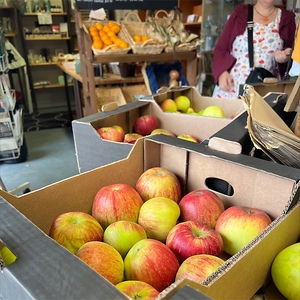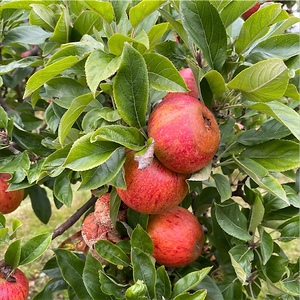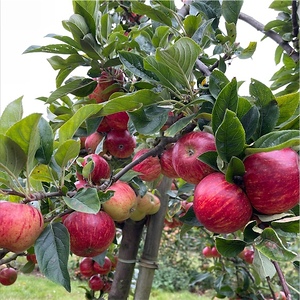


Charles Ross Apples
Estimated Inventory, lb : 0
Description/Taste
Charles Ross apples are a medium to large varietal, averaging 6 to 8 centimeters in diameter, and have a fairly uniform round to conical shape with broad flat shoulders tapering to a narrow base. The variety is traditionally larger than Cox's Orange Pippin apples, one of its parent varieties, and the stem is generally thick, brown, and woody. The apple's skin is semi-thin and taut with a faint sheen, and the surface ripens to a yellow-green hue streaked with distinct, broken dark red and orange striping and mottling. Some apples may also exhibit patches of brown russet. Underneath the surface, the ivory to cream-colored flesh is dense, coarse-grained, and aqueous with a crisp, succulent consistency. As the variety matures, the flesh develops a light and powdery texture. The flesh also envelops a central fibrous core filled with tiny dark brown-black seeds. Charles Ross apples are aromatic when ripe and have a sharp flavor off the tree. When left in a period of storage, the sharpness mellows and becomes sweet with honeyed, pear-like nuances.
Seasons/Availability
Charles Ross apples are available in the early fall through winter. Once harvested, the fruits can be held in professional cold storage into the spring.
Current Facts
Charles Ross apples, botanically classified as Malus domestica, are an heirloom English variety belonging to the Rosaceae family. The apples were developed in the 19th century and are a late-Victorian cultivar favored for their appearance and versatility. Charles Ross apples are often described as exhibition apples, meaning apple enthusiasts desire them for their striking coloring and large, uniform shape. The variety was widely planted throughout England and Scotland in the 19th and 20th centuries, and the trees are productive, compact, and resistant to scab. Over time, Charles Ross apples have faded from popularity in favor of modern cultivars, but some trees remain in specialty orchards. Charles Ross apples are a dual-purpose variety, consumed fresh or incorporated into cooked preparations, traditionally desserts. It is also worth noting that a sport of Charles Ross apples is called Red Charles Ross. This clone is often confused with Charles Ross and is sometimes sold interchangeably in farmer's markets.
Nutritional Value
Charles Ross apples are a source of fiber to regulate the digestive tract, calcium to build strong bones and teeth, and potassium to balance fluid levels within the body. The apples also provide vitamin C to strengthen the immune system, magnesium to regulate nerve functioning, vitamin B6 to maintain amino acid levels within the bloodstream, and other nutrients, including vitamin K, copper, boron, zinc, and manganese. The red streaking on the skin indicates the presence of antioxidants, which contribute anti-inflammatory properties to protect the cells against free radical damage.
Applications
The Charles Ross apple is an excellent dessert variety. It is also a good cooking apple because it retains its shape; they are particularly excellent in pies and crumbles. Their juiciness and flavor lends them well to cider-making as well. As with other apples, the Red Charles Ross pairs well with spices such as cinnamon and nutmeg when baking. With this apple, use less sugar than usual in recipes since it is so sweet. Charles Ross can be kept in proper cool, dry storage for one to two months.
Ethnic/Cultural Info
Charles Ross apples are known as an exhibition variety of apple rather than a common commercial variety.
Geography/History
Charles Ross apples are native to England and were created in the late 19th century. The variety was developed by breeder Charles Ross in Berkshire, England. Ross crossed Cox's Orange Pippin apples, a famous variety throughout England, with Peasgood's Nonsuch apples, an older cooking apple. After their release, Charles Ross apples were distributed across England and became a popular home garden variety. The apples were favored in private orchards for their hardy nature, and the species thrives in temperate climates, able to withstand frosts and cold temperatures. A natural mutation, also known as a sport, was developed from the variety and named Red Charles Ross apples. Today Charles Ross apples are an heirloom cultivar still present in private orchards but not commercially grown. When in season, Charles Ross apples are harvested from trees in England and Scotland and are sold through fresh local markets as a specialty cultivar.










